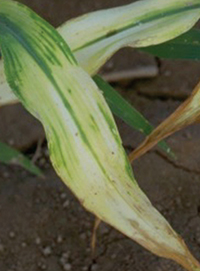 Strong residual weed control has been a hallmark of HPPD inhibitor (Group 27) herbicides for several decades. Chemistries like isoxaflutole, mesotrione, topramezone, tembotrione, bicyclopyrone and others offer improved weed control in corn, especially on glyphosate-, ALS- and atrazine-resistant weeds, including Palmer amaranth and waterhemp.
Strong residual weed control has been a hallmark of HPPD inhibitor (Group 27) herbicides for several decades. Chemistries like isoxaflutole, mesotrione, topramezone, tembotrione, bicyclopyrone and others offer improved weed control in corn, especially on glyphosate-, ALS- and atrazine-resistant weeds, including Palmer amaranth and waterhemp.
But under certain conditions these chemistries can injure corn or linger too long in the soil to impact the following year’s crop. Yield loss usually won’t occur if herbicides are applied according to label directions.
These herbicides block the function of hydroxyphenylpyruvate dioxygenase (HPPD), an enzyme that produces essential compounds for carotenoid pigments—causing plant leaf bleaching. They can be applied preemergence or postemergence as the compound is absorbed by both roots and leaves.
Corn injury to HPPD herbicides in the Midwest is rare unless misapplication occurs, according to Preshant Jha, Iowa State University Extension weed specialist. “Isoxaflutole without a safener when applied alone or with atrazine may cause bleached (white) corn.” Safeners help protect corn by increasing herbicide metabolism in the crop but not in the weed.
Agronomists and weed scientists recommend applying only one HPPD product per season and not exceeding the recommended rate for your soils. “Pay close attention to premix products that include an HPPD to select your best application rate and timing for your target weed problems,” Jha says.
HPPD Checklist
Courtesy: University of Illinois Extension
Follow these university-recommended guidelines and check the herbicide label to avoid problems:
- Follow recommended rates for specific soil types.
- Avoid sandy soils with low organic matter, poorly-drained soils, and excessively low or high pH.
- Plant seed at least 1.5 inches deep with good seed furrow closure.
- Use isoxazole with a safener.
- Avoid spray boom overlap to prevent exceeding label rates.
- Avoid ultra-early planting dates to prevent extended slow emergence under cold conditions.
- Avoid postemergence spraying when the corn is under stress extremes, such as hot and humid or cool and dry conditions.
The other challenge, if rotating to soybeans next year after your HPPD application on corn, is herbicide carryover.
Soybeans are susceptible to even trace amounts of HPPD chemistry, except for varieties with genetic tolerance to HPPD herbicides.
If the corn crop was sprayed with an HPPD late in the season, and if cool and dry weather persisted through the fall and winter to slow herbicide breakdown, be on the lookout for possible carryover. Work with a local agronomist or trusted advisor to assess the situation.
Like any herbicide, overuse can lead to HPPD resistance. So far, Palmer amaranth and waterhemp resistance to HPPD has been reported in Kansas, Illinois, Iowa, Nebraska, North Carolina and Wisconsin. The best advice to reduce resistance is to use three effective modes of action on every target weed in your field and rotate modes of action.
Content Provided by DTN/Progressive Farmer
The More You Grow
Find expert insights on agronomics, crop protection, farm operations and more.
